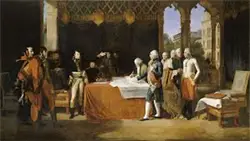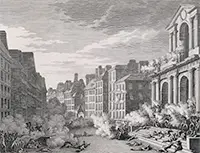The War of the First Coalition
Part 4: French Victory The King of Prussia had abandoned any pretense in fighting and in April 1795 agreed to the Peace of Basel, which gave France free rein on the left bank of the Rhine. During the intervening months, French armies had scored a knockout blow in the Low Countries, launching a winter attack that resulted in the establishment of the Batavian Republic, which otherwise was taking orders from Paris. At the same time, the grand duke of Tuscany abandoned the coalition, securing a separate peace with French forces. Spain followed suit in July, after long periods of inactivity punctuated by occasional sorties. Peace along the Pyrenees freed up French troops to retake Piedmont. France's enemies by this point were down to two: Austria and Great Britain. Perhaps the most significant development for the French army in 1795 was yet another change in government. On Aug. 22, 1795, the National Convention ratified a new Constitution, which provided for a bicameral legislature and a five-member executive to be called the Directory.
A rebellion of another kind occurred in October, just days after the new Constitution was declared in force, as a large number of royalists took up arms against the republican government and aimed to set up their own, dedicated to the return of a constitutional monarchy. The plan was to march down both banks of the Seine and converge on the Tuileries Palace, where the Convention was meeting. The insurgents never got to the palace. A group of soldiers led by Gen. Joachim Murat at the Sablons and a young Napoleon Bonaparte in front of the church of Saint Roch stopped the rebellion in its tracks. This was the famous "whiff of grapeshot" described by Bonaparte in later days. The result was hundreds of dead insurgents and the end of the last rebellion during the French Revolution. France then closed out the year with a November victory in Italy, at the Battle of Loano. The defeat of a joint Austrian-Sardinian force gave French troops access to northern Italy. Forgoing a winter attack through the cold months of 1796, France commissioned a series of attacks in Italy, led by Bonaparte. In the Montenotte Campaign, Bonaparte picked apart an Austrian-Sardinian force at Monetenotte and Millesimo and then, in April, inflicted such a heavy defeat on the Piedmontese army at Mondovi that the King of Sardinia signed a peace treaty that gave France Nice and Savoy. French forces under Bonaparte and Austrian forces under Dagobert Wurmser then chased each other around Italy for a time, with French troops seizing Milan and surrounding Mantua, settling in for a wintertime siege. A fierce victory at Arcole in November solidified French holdings in Italy. French forces in the north invaded Germany and claimed a significant amount of territory but lost it again, such that by October the front was much where it was at the start of the year. France's other enemy at this point, Britain, kept up a Mediterranean campaign, at first seizing Corsica but then leaving again later in the year in order to defend Gibraltar. Significantly, French forces under Louis Lazare Hoche finally ended the uprising in the Vendée, which had flared off and on for two years. 
Another Austrian attack designed to lift the siege ended in defeat, at the Battle of Rivoli. Mantua finally fell to French troops on Feb. 2, 1797, Austria surrendering after a long siege that claimed half of the soldiers who had sought refuge in the city. The 18,000 were all who remained; the others had died of starvation or disease. Bonaparte moved into high gear and marched into Austria itself; at the same time, the northern armies crossed the Rhine. Seeing no great armies coming from Britain or anyone else, Austria sued for peace. The Treaty of Leoben ended the War of the First Coalition (only after French troops put down a rebellion in Italy). British representatives did not sign the treaty, and that nation and France were technically still at war. First page > Revolution as a Cause for War > Page 1, 2, 3, 4 |
|
Social Studies for Kids
copyright 2002–2024
David White





